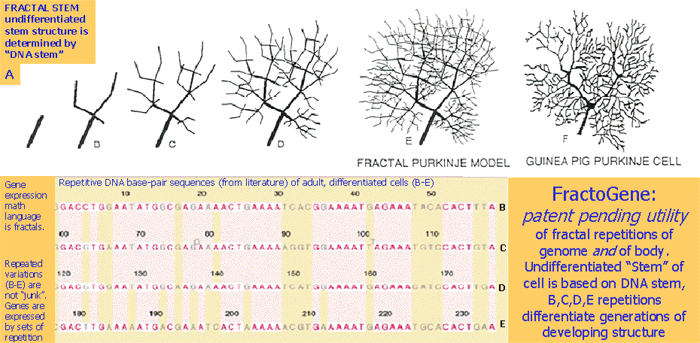
Summary diagram of the concept of Patent Pending FractoGene utility

For an Animated Display of the differentiation from stem by repeated fractal set, please click & stand by for full loading.
Each string of base-pairs defines a self-similar branching structure, in four generations, each specified by a "self-similar" base-pair sequence. The concept was specific, to connect the known "fractality" of DNA to (the also known) "fractality" of e.g. the specific platform of Purkinje cell.
However, the concept is both general and far-reaching, as it puts the fractal DNA and the organism developed by the DNA into a "cause and effect" relationship. The 2002 idea associated the fractal model of Purkinje cell (Pellionisz, 1989) with Fig. 4.18 (a repetitive DNA sequence from the literature). The "heureka!" of association (14th of February, 2002) triggered the concptual breakthrough of FractoGene.
Good luck generally favors the prepared. See an overview of a sustained effort through a third of a Century towards fractal roots of CNS morphogenesis.
Background: Collections are provided from the web, to outline the plausibility of the still "non-obvious" FractoGene:
A Gallery of visual demonstration that "self-similar" repetitive Natural objects are defined by fractal geometry.
The FractoGene-group patent-portfolio (2005) capitalizes on the inventive utility-implications of the new, non-obvious and useful concept. Since, however, the concept is also a paradigm-shift (a fractal geometrical generalization of the "gene" and "junk" concepts), the evolving synthesis is laden with the challenges of R&D of Intellectual Property protection in massive (Biotech-Nanotech-Infotech) Development vs. Academic Freedom of information in Research. In the initial patenting phase FractoGene was not accessible.
For workshops and peer-reviewed (peer invited) presentations, see "fugu prediction published" and "workshop presentation to peers" links.